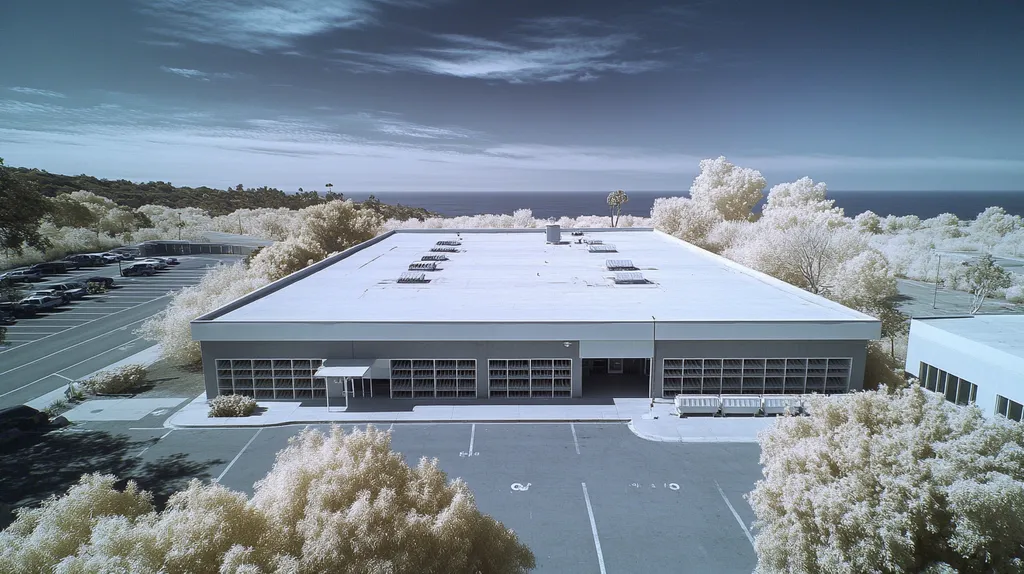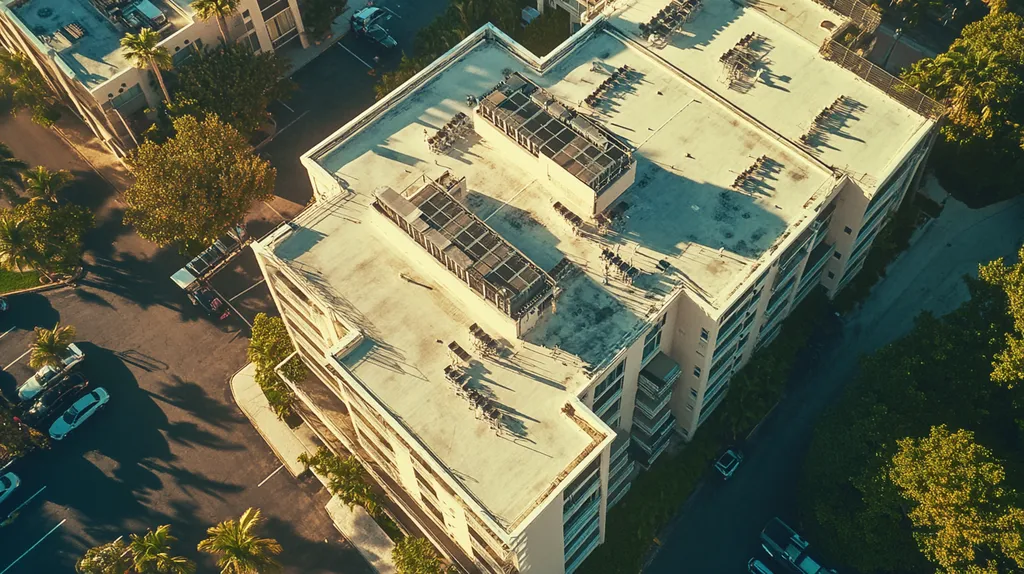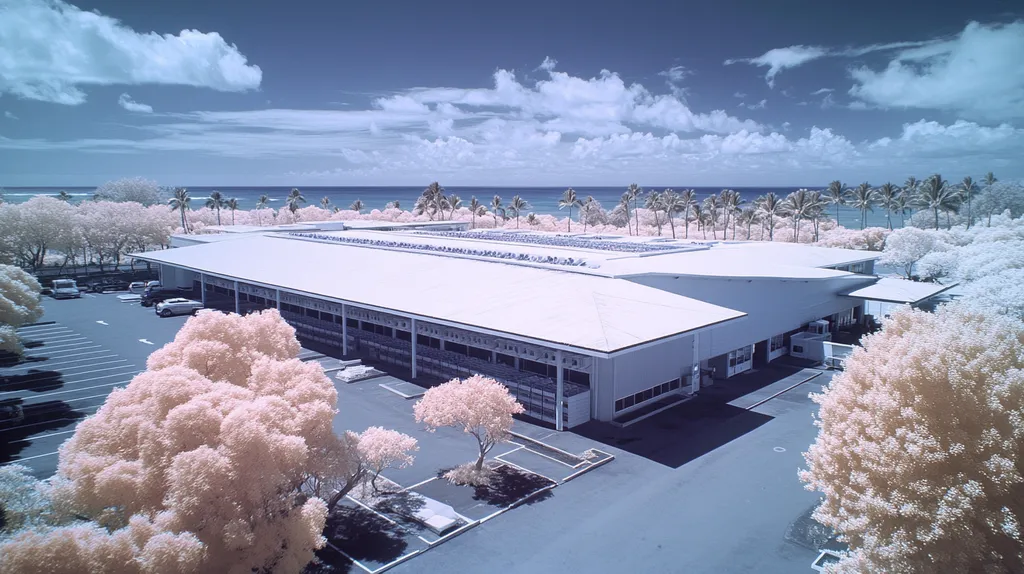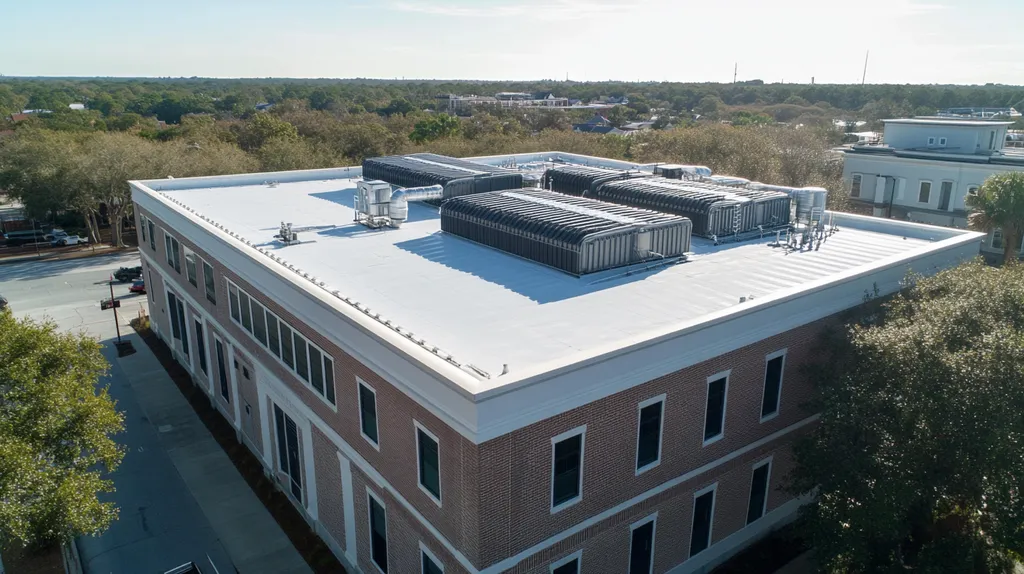Commercial property owners are facing a critical decision point as energy costs surge by up to 40% annually. Research shows that properly integrated solar panels can reduce commercial electricity expenses by 50-75% while extending roof lifespan.
Yet nearly 40% of commercial solar installations face preventable efficiency losses due to poor integration with existing roofing systems. This comprehensive guide provides property professionals with essential checklists across six key areas to ensure successful solar panel integration.
From performance optimization and financial planning to compliance requirements and risk management, these actionable steps help maximize solar investment returns while protecting the building envelope.
SECTION 1: PERFORMANCE FACTORS
Integrating solar panels into commercial roofing isn’t just a smart choice; it’s a vital strategy for reducing energy costs and promoting sustainability. With energy bills on the rise, optimizing rooftops for solar energy capture is becoming increasingly essential. Research shows that well-placed solar panels can save property owners over 30% on their electricity expenses. This section covers fundamental factors to assess when planning for solar integration, including roof orientation, shading influences, and optimal panel placement.
Assessing Roof Orientation and Tilt
The direction your roof faces has a major impact on solar panel efficiency. For maximum sun exposure, roofs should ideally face true south if they are located in the Northern Hemisphere. Additionally, the angle at which panels are mounted plays a crucial role; a tilt between 30 to 45 degrees is often recommended for capturing sunlight effectively throughout the year.
Property owners should consider an orientation assessment as one of the first steps in the planning process. A simple compass can help identify the roof’s direction. Using solar pathfinders or relevant apps can also illustrate the sun’s movement across various seasons.
For flat roofs, adjustable mounts are an excellent solution to achieve the ideal tilt. This helps ensure panels get as much sunlight as possible, leading to better energy generation and a higher return on investment.
Key Action Items
Evaluating Shading Impact on Solar Panels
Shading poses a significant threat to the efficiency of solar panels, making it essential to evaluate. Anything from nearby buildings to trees can cast shadows that hinder power generation. Even minor shading can drastically cut energy output—sometimes by as much as 50%.
A thorough shading analysis should be included in the site evaluation process. Employing shading calculators or simulation software can help property owners understand how shadows will affect solar panel performance throughout the seasons.
Effective landscaping or design modifications can also reduce shading challenges. Trimming or removing trees that obstruct sunlight is an effective way to maximize exposure and improve energy capture.
Key Action Items
Optimizing Panel Placement for Maximum Energy Capture
After evaluating roof orientation and shading, the next step is to optimize panel placement. Each installation has its unique characteristics, influenced by roof type, size, and local weather conditions. Experts often recommend clustering panels to streamline wiring and enhance layout efficiency.
Considering maintenance access when arranging panels is also crucial. Proper spacing is needed to allow for repairs without sacrificing solar performance. Thoughtful organization not only maximizes energy capture but also supports long-term sustainability.
Property owners should stay informed about technological advancements that can boost solar panel efficiency. For instance, utilizing microinverters or optimizers can significantly enhance output, even for shaded panels.
Key Action Items
SECTION 2: FINANCIAL CONSIDERATIONS
With energy costs climbing and sustainability becoming a priority, property owners must closely evaluate the financial aspects of integrating solar panels. A recent study shows that businesses can slash utility bills by up to 75% when they harness solar energy. Having a clear understanding of the financial implications of solar investment not only helps decision-makers ensure a robust return but also bolsters long-term sustainability efforts.
Calculating ROI and Payback Period
Understanding the return on investment (ROI) for solar panel systems is vital for property professionals. This involves factoring in initial installation costs, anticipated energy savings, and potential increases in property value. Typically, solar installations offer a payback period of 4 to 7 years, depending on the size of the system and the building’s energy efficiency.
Property owners should also consider the long-term benefits, including lower maintenance expenses and a prolonged roof lifespan, which can significantly enhance ROI. A comprehensive financial analysis that includes utility rates, available solar incentives, and financing options will provide crucial insights into the total cost of ownership.
Utilizing real-time data and analytics will further enable property managers to track energy production and consumption. This allows for adjustments in energy strategies that can maximize savings and improve overall ROI.
Key Action Items
Exploring Incentives and Tax Credits
Incentives and tax credits play a crucial role in the financial feasibility of solar projects. For instance, the federal Investment Tax Credit (ITC) allows property owners to deduct a significant percentage of solar installation costs from their federal taxes, reducing upfront investments and making solar energy more appealing.
In addition to federal benefits, many states provide further incentives such as rebates or performance-based rewards, lowering the net cost even more. It’s essential for property owners to investigate local utility programs and state-level incentives to ensure they take full advantage of available funding.
Staying updated on legislative changes can also maximize these benefits. Recognizing new incentives or policy shifts can lead to notable savings, making solar integration not only financially viable but strategically advantageous.
Key Action Items
Budgeting for Installation and Maintenance
Creating a solid budget for both the installation and ongoing maintenance of solar panels is key to successful integration. Initial installation costs vary, influenced by factors like system size, roof type, and complexity. Performing a detailed cost analysis at the start helps property owners establish realistic budgets and timelines.
Additionally, property owners should account for regular maintenance, which can range from 1% to 2% of the total installation cost annually. Incorporating these costs can help manage financial expectations and extend the lifespan of the solar systems.
Exploring financing options, such as solar loans or leases, also provides flexibility in payment plans while easing the initial financial load. Evaluating these options closely will help align financing with overall budgetary needs.
Key Action Items
SECTION 3: COMPLIANCE REQUIREMENTS
Successfully integrating solar panels into commercial rooftops is essential for energy efficiency and sustainability—but it comes with its challenges. Compliance with local regulations and codes is imperative to avoid setbacks. Alarmingly, studies reveal that nearly 30% of commercial solar projects run into compliance issues, leading to delays and added costs. Understanding and addressing these compliance requirements is crucial for a smooth installation process.
Meeting Local Building Codes and Regulations
Navigating local building codes and regulations is a must for property professionals when integrating solar panels. These codes are designed to ensure the safety and integrity of buildings. Ignoring them can lead to serious legal problems and financial losses.
For example, many municipalities necessitate a structural assessment prior to installing solar panels to confirm that the existing roof can support the weight of the solar system. Understanding these regulations early can prevent headaches down the line.
Additionally, zoning laws can stipulate specific placement for solar panels, impacting design decisions. Being aware of these local rules plays a key role in enhancing project approval chances and avoiding costly mistakes.
Key Action Items
Ensuring Electrical Infrastructure Compliance
The electrical infrastructure must align with solar systems to ensure effective and safe energy production. Property owners must verify that wiring and electrical components meet the National Electrical Code (NEC) and local modifications. Compliance isn’t just about avoiding fines; it’s critical for safety.
Connecting solar panels to the existing grid requires thorough inspections and possibly upgrades to the current wiring. This ensures the system can handle the energy load effectively.
When integrating energy storage systems like batteries, additional compliance checks are necessary to ensure safety standards are met to avoid risks like electrical fires. Early consultations with qualified electrical engineers streamline this crucial aspect.
Key Action Items
Adhering to Roofing Material Compatibility Standards
The choice of roofing materials affects both solar performance and longevity. Compliance with roofing material compatibility standards is vital. Using unsuitable materials can lead to costly leaks and damage, impacting the solar system’s effectiveness over time.
Certain single-ply membranes, for instance, may need specific adhesives or fasteners to accommodate solar panel installation properly. It’s important for property owners to ensure that their roofing warranty is not compromised during integration.
Engaging roofing and solar installation experts can confirm material compatibility, helping to identify potential issues upfront. This proactive approach not only safeguards the roofing system but also boosts the durability and return on investment for solar installations.
Key Action Items
SECTION 4: RISK MANAGEMENT
Integrating solar panels onto commercial roofs is a significant undertaking that carries inherent risks requiring careful management. Failure to address these risks can lead to expensive repairs and operational disruptions, potentially compromising energy efficiency. Alarmingly, around 50% of roofing failures are attributed to insufficient structural support and water leaks, making risk management a priority. This section will highlight crucial strategies focusing on structural capacity, water leakage prevention, and shading challenges.
Assessing Roof Structural Capacity and Integrity
The strength and condition of a commercial roof are pivotal when adding solar panels. Property managers must confirm that the existing structure can bear the extra weight of solar systems. Engaging a structural engineer for a thorough assessment can clarify the roof’s load capacity and ensure compliance with safety standards.
For example, while flat roofs may appear ideal for solar installations, if they are nearing the end of their lifespan, adding solar panels could aggravate existing structural issues. Utilizing advanced simulation software can predict how well the roof will hold up under the new loads.
Conducting regular inspections is also vital both before and after installation. These assessments can uncover any concerns such as cracks or material wear that could diminish the effectiveness of the solar array. By guaranteeing architectural integrity, property owners safeguard their investments and promote the sustained success of their solar initiatives.
Key Action Items
Mitigating Potential Water Leakage Risks
Water leakage is among the top concerns when integrating solar systems on commercial roofs. Poor sealing and incorrect installation can create vulnerability points for water intrusion, leading to expensive repairs. Therefore, implementing effective preventative measures is crucial.
For instance, installing high-quality waterproofing membranes and ensuring proper flashing around penetrations can significantly minimize the risk of leaks. Roofing materials like EPDM or TPO, when installed correctly, provide robust durability and water resistance.
Routine maintenance checks should prioritize inspecting areas around mounting systems and other penetrations for potential issues. A minor crack can evolve into serious water intrusion if neglected, causing damage to both the roofing system and the interior spaces. A proactive water management strategy is essential, encompassing regular inspections and effective drainage systems to direct water away from critical locations.
Key Action Items
Managing Shading and Obstruction Issues
Shade and obstructions can significantly hinder the performance of solar panels. Property managers must evaluate potential shading sources like nearby buildings, trees, and existing rooftop equipment that may affect new installations.
Conducting a comprehensive solar site assessment before installation is vital in identifying potential shading issues. This assessment should determine where shadows may fall and suggest optimal panel placements that maximize solar capture.
Utilizing solar pathfinder tools can yield valuable insights into sun patterns across the seasons, guiding informed decisions on panel positioning. Properly configured systems not only enhance energy harvest but also reduce potential long-term financial setbacks. Moreover, continuous monitoring of panel performance is crucial to swiftly address any new shading challenges that may arise.
Key Action Items
SECTION 5: OPERATIONAL PROCEDURES
Integrating solar panels into commercial roofs involves rigorous planning and careful execution to ensure optimal performance and maximize investment. Property professionals must prioritize operational procedures to avoid pitfalls that could jeopardize the functionality and lifespan of both the roofing system and the solar installation. This section highlights critical operational procedures to enhance efficiency in solar integration efforts.
Conducting Pre-Installation Roof Inspections
Before installation, thorough roof inspections are crucial to assess the structural integrity and suitability for solar systems. Property owners should enlist certified roofing experts to analyze the roof’s age, material condition, and load-bearing capacity. For example, flat roofs may require additional reinforcement to safely support the weight of solar panels.
Identifying potential issues early on can prevent significant costs later. It’s essential to evaluate roof penetrations, drainage systems, and existing HVAC equipment during this inspection. Retroactively installing solar panels over a compromised membrane can result in leaks and further maintenance complications.
A detailed inspection not only aids in selecting the appropriate mounting system but also protects long-term investments. Maintaining documentation of these evaluations offers valuable insights for future maintenance and warranty claims.
Key Action Items
Implementing Efficient Installation Methods
Utilizing efficient installation techniques is critical for the success of solar panel integration. Hiring contractors who specialize in both roofing and solar installations can streamline the process. Collaboration between roofing specialists and solar installers ensures consistent adherence to best practices.
Employing innovative mounting systems can minimize damage to roofing materials. For example, using ballasted solar panel systems allows for installation without penetrating the roof, preserving its integrity and reducing the risk of leaks.
Strictly following local building codes throughout the installation process is vital for safety and can simplify inspections and ensure timely permitting. Investing in training for on-site personnel can enhance efficiency, enabling a skilled workforce familiar with roofing and solar technologies to reduce installation duration and improve project outcomes.
Key Action Items
Scheduling Regular Maintenance and Cleaning
Once solar panels are in place, regular maintenance and cleaning are essential for maintaining optimal efficiency. Dirt, debris, and environmental factors can accumulate on panels, significantly lowering energy output. Property managers should create a consistent cleaning schedule to enhance performance.
Routine inspections should also continue after installation to identify any wear or damage that might arise. Early detection of issues is critical to avoid costly repairs and to ensure solar systems maintain their functionality and efficiency.
Incorporating monitoring systems can provide real-time insights into energy production and alert management to any potential issues. Such proactive measures help maintain system integrity and optimize performance, ensuring a strong return on investment.
Key Action Items
SECTION 5: OPERATIONAL PROCEDURES
Integrating solar panels into commercial roofs is a critical process that requires careful planning and execution. Property professionals must prioritize operational procedures to ensure efficiency and maximize returns on investment. Without proper pre-installation assessments, effective installations, and routine maintenance protocols, both the roofing system and the solar installation risk reduced functionality and lifespan. This section outlines essential operational procedures to facilitate efficient solar integration.
Conducting Pre-Installation Roof Inspections
Before any installation begins, comprehensive roof inspections are essential to evaluate structural integrity and compatibility with solar systems. Property owners should hire certified roofing professionals to assess factors such as the roof’s age, material condition, and load-bearing capacity. For example, flat roofs might require reinforcement to support the additional weight of solar panels.
Early identification of potential issues can help avoid significant costs later. During the assessment, it’s crucial to examine roof penetrations, drainage systems, and existing HVAC equipment. Installing solar panels over a compromised membrane could lead to leaks and further maintenance challenges.
A thorough inspection also aids in selecting the most appropriate mounting system for the solar panels. This proactive measure minimizes future repair costs, ensuring both the solar panels and roofing system last longer.
Keep detailed documentation of these inspections. Proper records can provide valuable insights for future maintenance and potential warranty claims.
Key Action Items
Implementing Efficient Installation Methods
Utilizing efficient installation methods is crucial for successful solar panel integration. Engaging contractors with expertise in both roofing and solar systems can streamline the process. Collaboration between roofing specialists and solar installers ensures adherence to best practices.
The application of innovative mounting systems helps to reduce potential damage to roofing materials. For instance, ballasted solar panel systems can be installed without penetrating the roof, thereby preserving its integrity and lowering the risk of leaks.
Adherence to local building codes and regulations during installation is essential for safety and can facilitate smoother inspections and permitting processes. Training staff on best practices enhances operational efficiency, enabling a workforce adept in both roofing and solar technologies to reduce installation time and improve project outcomes.
Key Action Items
Scheduling Regular Maintenance and Cleaning
After the installation of solar panels, ongoing maintenance and cleaning become vital for sustaining their operational efficiency. Accumulation of dirt, debris, and environmental factors can significantly reduce solar energy production. Property managers should establish a regular cleaning schedule to ensure optimal performance.
Additionally, routine roof inspections should continue after the solar panels are installed. Early detection of wear or damage can prevent costly repairs and maintain the solar systems’ performance.
Incorporating monitoring systems gives real-time insights into energy production and alerts management to any potential concerns. Such proactive measures help maintain system integrity and optimize performance, ensuring a strong return on investment.
Key Action Items
Looking Ahead
With energy costs projected to rise 40% by 2025, commercial property owners can no longer afford to delay solar integration decisions. Research shows properly installed solar systems deliver 50-75% energy savings while extending roof lifespans by 10-15 years.
Success requires careful attention to the six key areas outlined in this guide: performance optimization, financial planning, compliance, risk management, operational procedures, and long-term considerations.
Property professionals who follow these actionable checklists position themselves to capture maximum value from their solar investments while avoiding costly mistakes that plague 40% of commercial installations.
The time for solar integration is now – but only those who execute with strategic planning and attention to detail will realize the full potential of this transformative technology.
FREQUENTLY ASKED QUESTIONS
Q. How does roof orientation affect a commercial roof’s solar energy efficiency?
A. The direction your commercial roof faces significantly impacts solar panel efficiency. Ideally, roofs should face true south for maximum sunlight exposure. A tilt of 30 to 45 degrees is recommended, as it improves sunlight capture throughout the year.
Q. What financial considerations should I make for my industrial roof solar project?
A. A thorough financial analysis is crucial when planning solar integration for your industrial roof. This includes evaluating installation costs, expected energy savings, potential property value increases, and exploring available incentives or tax credits that can lower costs.
Q. How can I ensure compliance with my commercial roof solar installation?
A. To ensure compliance, familiarize yourself with local building codes and zoning laws. Conduct necessary structural assessments and consult local officials to understand requirements, preventing costly legal issues and delays during your solar installation.
Q. What risks should I manage when adding solar panels to my commercial roof?
A. When adding solar panels, it’s vital to assess the roof’s structural integrity to support the added weight and to implement water leakage prevention measures. Conduct regular inspections and address shading or obstruction issues that could hinder solar performance.
Q. What operational procedures are essential for solar panel integration on roofs?
A. Effective operational procedures include conducting pre-installation roof inspections, engaging qualified contractors, and scheduling regular maintenance and cleaning of the solar panels post-installation, ensuring optimal performance and longevity of both systems.
Q. How do I choose the right solar panel technology for my commercial roof?
A. Selecting the right solar panel technology involves analyzing your energy needs, roof type, and budget. Consider factors such as efficiency ratings, durability, warranty terms, and whether newer technologies like monocrystalline panels suit your specific requirements for solar energy capture.











